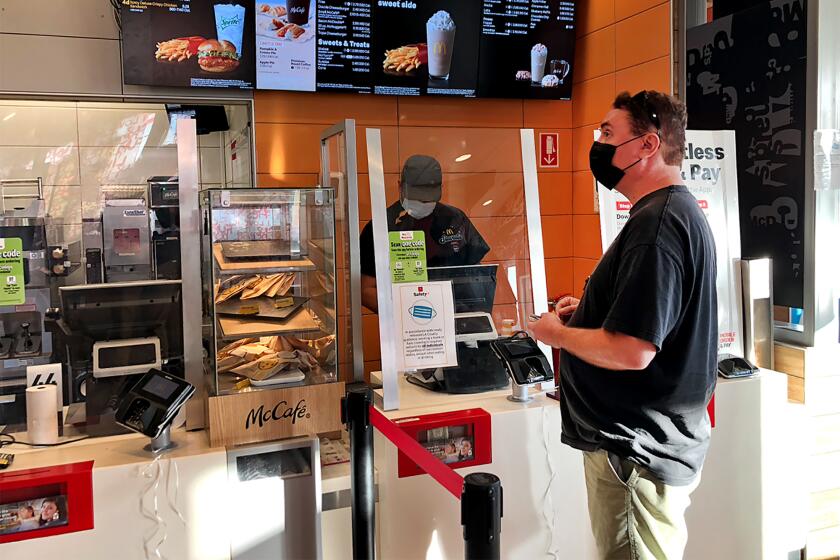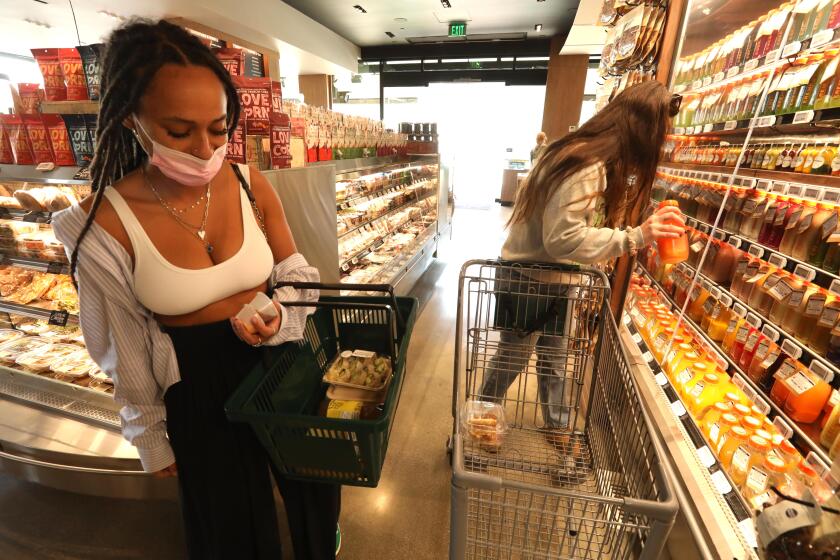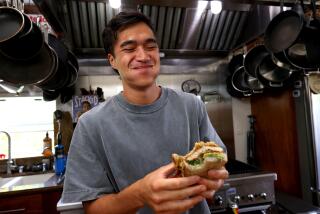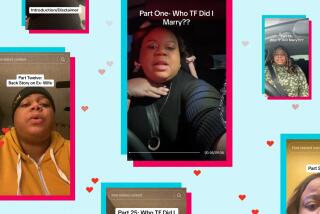His gross fast-food TikToks went viral. But making a living from TikTok isn’t easy
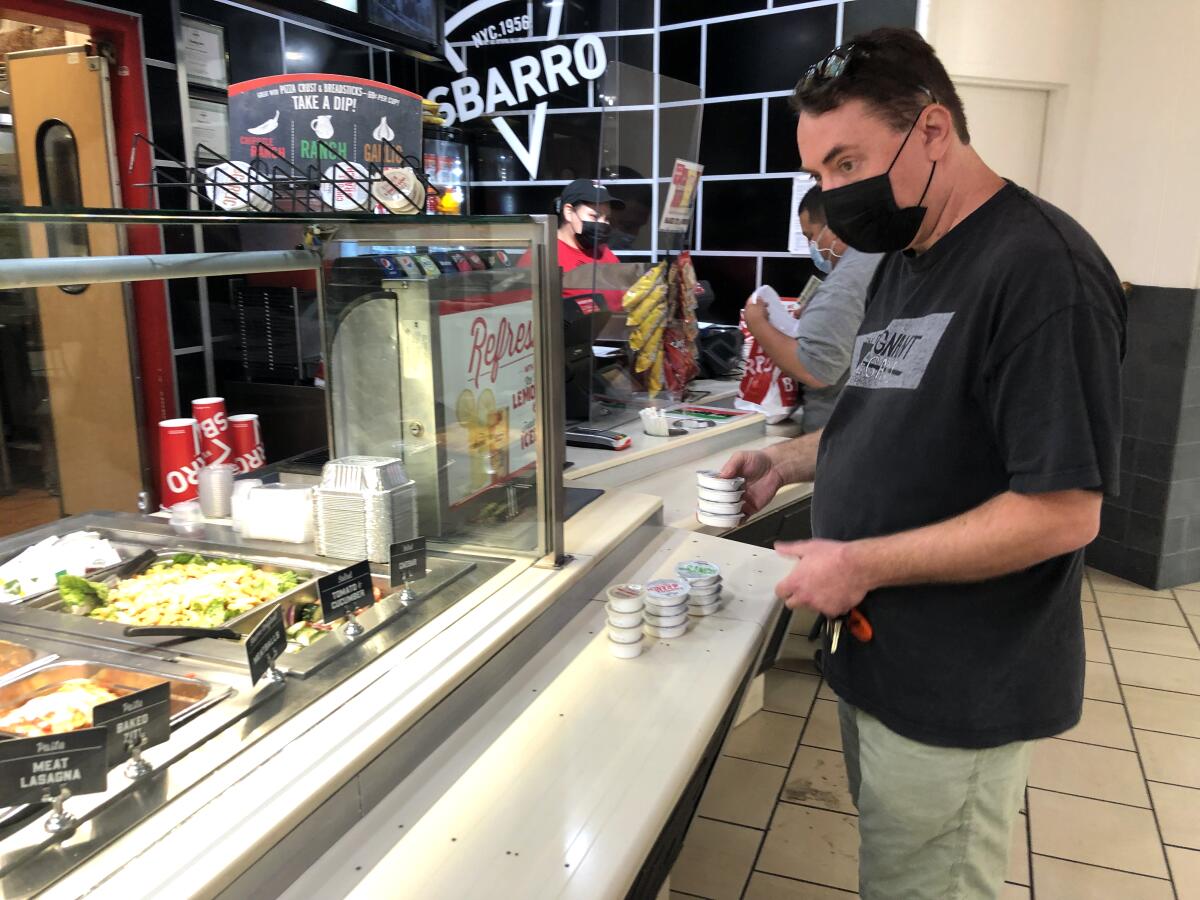
In the parking lot of a southeast Los Angeles Jack in the Box, Sam Pocker offers me some advice: In dealing with the fast-food chain’s “secret sauce,” refrigeration is key. Leave the packets in a hot car for too long and they’re liable to explode.
“I thought that was a joke,” he tells me as we pull into the drive-through, “until they started fermenting.”
When it comes to condiments, Pocker, 45, doesn’t kid around. They are, after all, his stock in trade, if not quite yet the foundation of his livelihood. Working under the handle @FastFoodLegend, Pocker has intermittently gone viral on TikTok for a series of gross-out videos that find him dumping ungodly amounts of sauces and flavorings atop hot dogs, hamburgers and more, for an effect that’s less appetizing than it is artistic.
“Unwrap a bacon, egg and cheese,” instructs one of his best-performing videos, a Starbucks breakfast sandwich “hack” that’s been viewed more than 4.4 million times. “Add a packet of In-N-Out Burger ketchup. Add a packet of Checkers honey mustard. Add a packet of Red Robin original seasoning. Add a packet of Tapatío.”
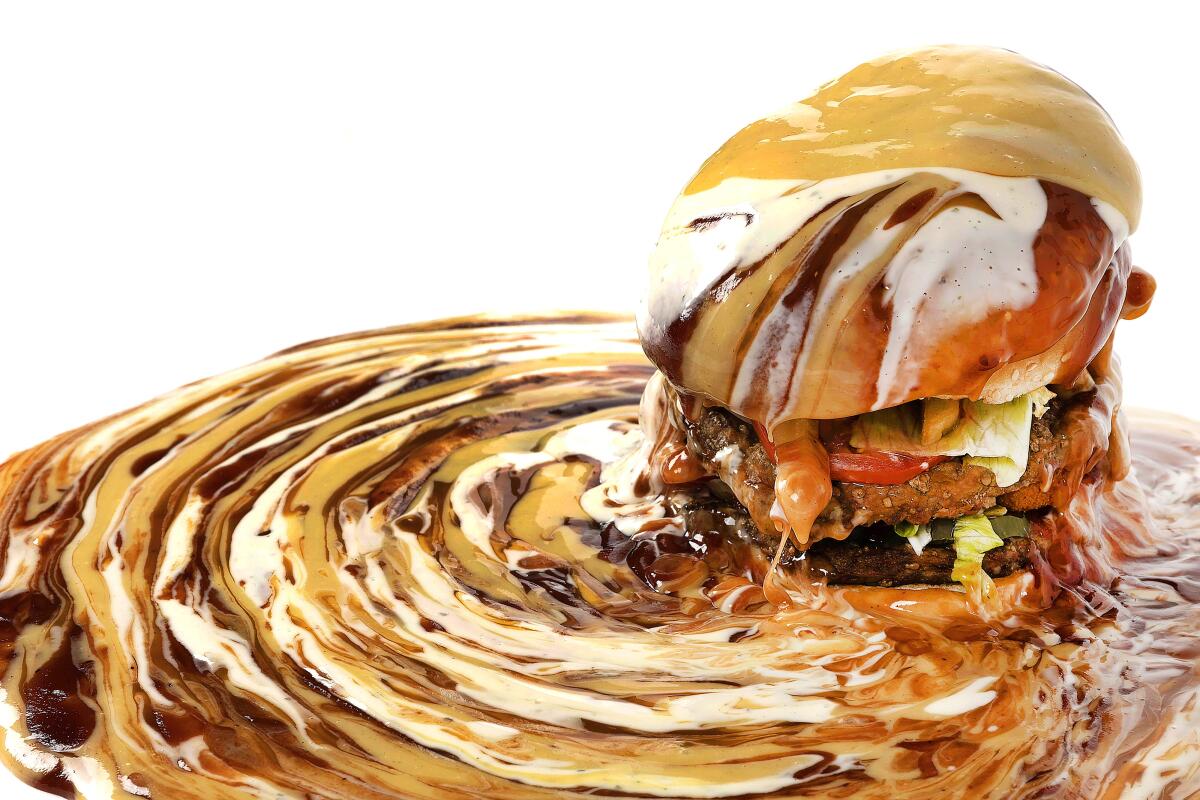
As TikTok’s text-to-speech assistant names each condiment, Pocker — unseen but for his hands — pours it over the sandwich. Three minutes and 34 sauces later, the result looks less like a meal than an exploded Sherwin-Williams paint factory.
Pocker’s videos are bizarre, visually engaging pieces of performance art, and they sometimes catch the attention of TikTok’s fickle content recommendation algorithm. Since starting the project last June, Pocker has amassed enough fans that he now has access to TikTok’s Creator Fund, which lets him make money off his posts, and Creator Marketplace, which helps corporate sponsors hire him for brand deals. (He said that he’s earned about $600 on the former, and received but not accepted any offers on the latter.)
But internet fame is a tricky beast to wrangle. Many of Pocker’s posts get only a couple of hundred views — not just the sauce-dumping ones but also Muppets-esque skits in which googly-eyed hamburgers discuss self-care and lip-sync to Madonna. These are mostly filler, Pocker concedes, but are cheap to make. Plus, they boost his publish rate, which leaked documents indicate is a key metric for TikTok.
“TikTok is quantity over quality,” he said. “You’ve gotta keep feeding the machine.”
How hard is it to make money as a social media influencer? Take a peek inside the budget of Sam Pocker, a TikTok artist focused on fast food.
Yet each @FastFoodLegend video — even the ones hardly anyone watches — requires time, energy and money to produce. Pocker says he puts more than 40 hours of work into the account every week and has spent hundreds of dollars on camera equipment, lights and editing software. He tracks fast-food trends on social media and reads the industry trade paper QSR every day in search of new ideas. He has a second phone for all his fast-food apps so that he’ll get notified whenever chains announce new deals. He even uses EBay to track down rare condiments; in what he describes as “a huge score,” a hoarder once sold him hundreds of packets of a picante sauce McDonald’s no longer makes.
One of the biggest drains on Pocker’s resources is his weekly schedule of “shopping trips,” during which he drives out into the Los Angeles sprawl and buys the bulk of the sauces, sandwiches and sides he demolishes on camera.
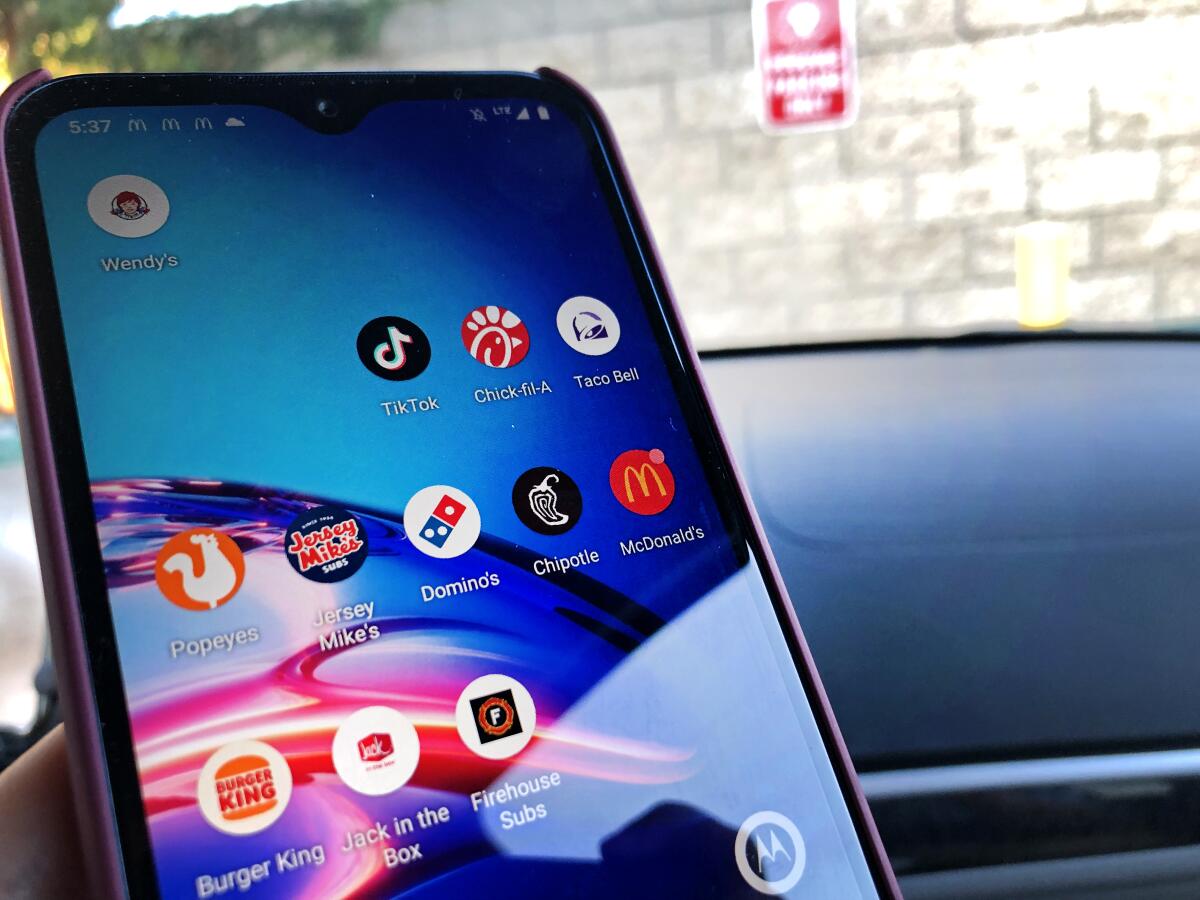
It is on one of those trips that the two of us find ourselves in Downey, chatting about exploding condiment packets in a slow-moving drive-through lane. Pocker’s strategic sauce reserves are running dangerously low — back home in Hollywood, the shoebox filing system in which he organizes his supplies is down to little more than barbecue sauce and mustard — and he needs to restock.
At the same time, we are on the hunt for loads and loads of French fries; Pocker has plans for a video in which he’ll mix them into the world’s least appetizing potato salad. To contain the smell of the fries, he’s brought along an insulated Grubhub bag; otherwise, he warns, “we will go crazy.”
Jack in the Box is our first stop of many. When we’d first set out, winding south down Interstate 5 to the tune of SiriusXM’s TikTok Radio, I’d noticed a handwritten note stuck to the central console of Pocker’s SUV. It listed the names of fast-food chains he hoped to stop at; we would end up visiting 18 of them.
After paying $2.59 for the Jack in the Box order, Pocker and I head down the street to the next stop on our itinerary: Burger King. “I need to buy French fries,” Pocker tells the cashier once we’re inside. “But I also want to buy, like, 10 breakfast syrups and 10 zesty sauces.”
“I’m happy to pay,” he quickly adds.
“How many French fries?” the cashier asks.
“Just one.”
“Only one order of French fries?”
“Yup,” Pocker says — and a small one at that. Final price: $8.35.
Logan Paul had one of the biggest megaphones on YouTube and left it behind for a corner of the internet where he can be his full, unrestricted self. But he’s been unable to escape thorny questions about the proper limits of online speech.
As eccentric as his orders are, staff rarely question Pocker. “The only question people really ever ask is, they think I want it for free,” he tells me back in the car. “That’s why I’m so upfront about, ‘I’m happy to pay.’ Sometimes I have to say I’m happy to pay, like, five or six times till it gets through their head.”
Paying for all these orders adds up. Over the course of the day, I watch as Pocker buys, among other things, hash browns at Dunkin’ Donuts ($1.49); fries and a packet of both sweet-and-sour sauce and barbecue sauce at McDonald’s ($1.64); fries and two packets of ghost pepper ranch sauce at Wendy’s ($2.96); five packets each of breakfast syrup, hot mustard, honey mustard, sweet-and-sour sauce, barbecue sauce, spicy buffalo sauce and creamy ranch sauce at a second McDonald’s ($7.70); Cajun fries and five packets each of the cocktail, bayou buffalo, sweet heat, Mardi Gras Mustard and blackened ranch sauces at Popeyes ($10.19); and one serving of crazy sauce plus five cups each of the ranch, buffalo ranch, “cheezy” jalapeño and butter garlic dipping sauces at Little Caesars ($14.88). [Pocker logged a full week’s worth of his expenditures and shared it with The Times here.]
The @FastFoodLegend project is still in what Pocker euphemistically refers to as its “startup phase” — that is, he’s losing money on it. But, he adds, “it’s such a small amount of money in the scheme of things, it’s tolerable.”
In the meantime, he scrapes by on freelance writing gigs: resumes, business letters, art catalogs, government paperwork.
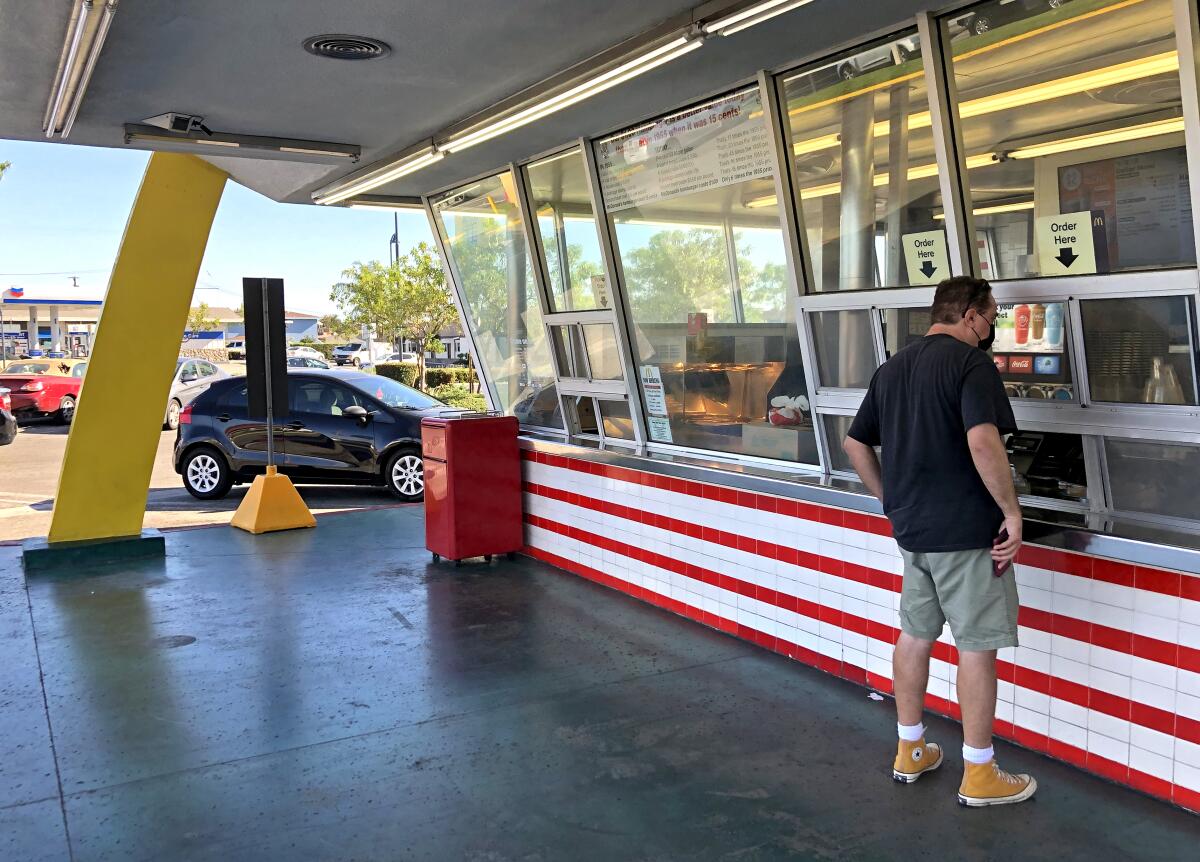
As we walk around Stonewood Center — a local shopping mall with plenty of fast-food vendors to choose from — Pocker tells me that his social media presence wasn’t always so tongue-in-cheek. Before he became a TikTok provocateur, he was trying to make it big as a more traditional Instagram food blogger.
“The whole thing is, do you have enough money to keep that going until you get to the point that you get income from it?” he says. “I started on that path for a minute.”
His first stab at the genre sent him to Whittier, where a restaurant was selling made-for-Instagram hamburgers with an entire beef rib stuck between the buns. Pocker snapped photos aplenty, but when he finally took a bite, the meal was tasteless: “Like eating air,” he recalls.
That sense of wastefulness and performative excess would stick with Pocker as he continued his food blogging efforts on Instagram — and eventually on TikTok, too, after he noticed that foodie content also performed well there. (Gordon Ramsay, a celebrity chef with more than 30 million followers, and Emily Mariko, a food influencer with more than 9 million followers, are among the platform’s biggest names. Cooking content is so popular on TikTok that the company is now launching a restaurant business built around viral food trends.)
“In the course of doing that, I said, well, let’s do it with cheap food,” he says as we walk around the mall, searching Sbarro, Wetzel’s Pretzels and Cinnabon for more sauces. “As a matter of fact, let’s do it with the worst food possible.”
His early efforts to pivot to fast-food content were “all crap.” But before giving up, he had an idea: “What if I get one sauce from every place [and] pour it on one burger?”
Influencers can find fame and fortune on TikTok — but only if their videos stay up. Communities of online trolls and coders say they have tools to keep that from happening.
He chose a Big Mac as his canvas — “the most basic, American, easy-to-understand hamburger” — and drenched it in a rainbow of condiments. The video did well, pulling in a couple of hundred thousand views. But subsequent riffs on the concept barely broke double digits.
The project seemed dead in the water. But a few days later, he checked on the Big Mac video — and saw that its view count had started rising again. By the next morning it had passed a million views, then hit 2 million a day later, and was at 3 million within a week. It’s now at nearly 5 million.
His breakout success convinced Pocker that TikTok could become a real career. He set aside a sizable budget to produce new videos, took a Udemy course on TikTok marketing and started churning out more content. He was soon admitted to the Creator Fund — a monetization feature TikTok reserves for accounts with at least 10,000 followers and 100,000 recent views.
“The ironic thing,” he tells me, “is most of the takeout I eat is actually from Erewhon.”
Elite grocery chain Erewhon is embarking on an aggressive expansion in Southern California. Started as a humble bulk grains outlet, its cult success is rewriting the rules of the supermarket business.
He attributes his success in part to the long list of jobs, hobbies and side hustles he’s taken up over his lifetime. He worked as a ticket salesman in his teens, and in his twenties got involved with couponing, which he now credits with making him comfortable around store managers. He dropped out of college but intermittently studied art at the School of Visual Arts, Parsons School of Design and Fashion Institute of Technology.
A string of creative pursuits filled his twenties and thirties: podcasts, zines, several books, a documentary about couponing, a speed-dating company, a pie stand and an incomplete series of 365 holiday-themed dioramas. Coming off the back of a divorce and a bankruptcy in his late thirties, Pocker began making music, then moved to Los Angeles in 2016. (Since starting @FastFoodLegend last summer he’s been able to score some TikToks with his own songs — and collect minor royalties in the process.)
“This particular niche on TikTok,” Pocker said, “is the perfect culmination of all my weird skills.”
It’s also a continuation of a theme he’s explored in past works of art: American consumerism. His goal is to “make people challenge their beliefs … about any kind of marketing” and shock them into rethinking their relationship with “the burgers, or fast-food system, or how they eat.”
“It’s just like any other art,” he said, “only I’m doing it with this dumb stuff. That makes people really mad — so that’s kind of fun. Because that’s what social media is; angry people click more.”
Pocker’s goal is to eventually make his living on TikTok. “I don’t need to be a millionaire,” he said. “I enjoy doing the work. So if I could do the work to a point that it would just pay the bills and whatever, I’d be perfectly happy.”
That’s an increasingly common ambition, particularly among teenagers, but few are able to pull it off. As Pocker and I leave Downey for our final stop of the day, a West Adams Heights ghost kitchen that handles takeout orders for Nathan’s Famous, he opens up about his frustrations with trying to make @FastFoodLegend self-sustaining.
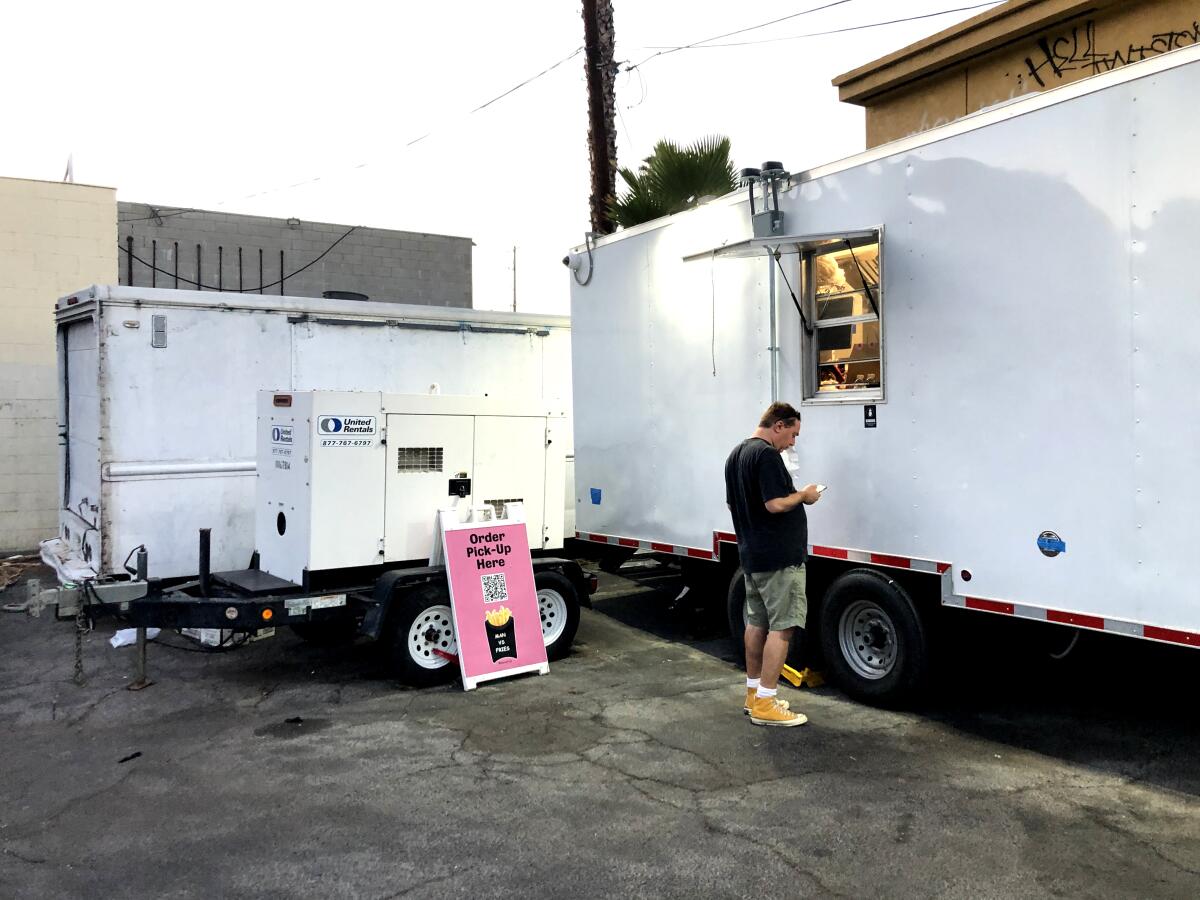
“If you said to me, ‘You just have to do TikTok’ and that was it, I would be so happy,” he says. “Whereas I can’t; I gotta do a lot of other things. … I make the TikTok the priority, but it’s hard.”
Earlier in the day, he’d said that he felt like the platform offered him a realistic path toward financial sustainability. After “one or two more bumps of popularity,” he said, he anticipated that he’d start getting bigger sponsorship offers — maybe he’d even partner with some cleaning supply companies.
But as we curve around the downtown L.A. skyline on our way to the ghost kitchen, he’s more circumspect. When I ask whether TikTok has enough users who share in his interests that he could eventually build an audience of the size he wants, Pocker says no.
“I really burned out on social media a long time ago,” he adds. When he watches other people’s TikToks, it’s to generate ideas for more content, not because he likes it. “The thing with consuming social media for me is that I don’t find most of it very interesting, and I do find it really depressing.”
Worth noting here: Pocker’s No. 1 song on Spotify is titled “TTMMWKM” — that is, “TikTok Makes Me Wanna Kill Myself.”
By the time we pull up to the ghost kitchen, a nondescript trailer in the parking lot behind a Salvadoran restaurant, dusk has started to settle in over Los Angeles. While we wait for our Nathan’s Famous order, Pocker lays the rest of the day’s fry haul on the hood of his SUV like a big-game hunter returned victorious from the backwoods.
Nearly five hours after we first set out, it’s the end of my journey with Pocker — but for him the work is only just beginning. Now that he has his raw material, he has to actually make some TikToks with it — and he has to do it quickly, before the fries go bad. (The many sauce packets we’ve gathered will last longer.)
“I’ve gotta just film it tonight,” he says of the potato salad video, estimating that setup will take half an hour; the shoot itself, 15 minutes; cleanup another half an hour; and the editing, three hours. “It’s a full day to make a video that might ultimately be seven seconds long.”
Over the course of the next two weeks, Pocker ends up making four videos with all the fries. Together, they net him a combined 4,191 views, 252 likes and 16 comments.
“I’d be shocked if I even made five cents in royalties,” Pocker said in an email.
But he doesn’t yet consider the series a failure: “It’s still a work in progress.” Some of his most successful videos have started off with unimpressive engagement, only to later blow up after he posted a different cut. Maybe some other version of the fry video will eventually turn a day’s worth of salt, grease and potato chunks into a viral sensation, too.
